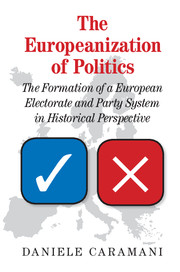 The Europeanization of Politics
The Europeanization of Politics Book contents
- Frontmatter
- Contents
- List of Figures
- List of Tables
- Preface and Acknowledgements
- List of Abbreviations
- Introduction: Electoral Integration in Europe
- Part I Framework
- Part II Analysis
- 3 Homogeneity: Convergence and Deviation in European Electoral Development, 1848–2012
- 4 Uniformity: Electoral Waves and Electoral Swings across Europe, 1848–2012
- 5 Correspondence: Overlapping versus Distinctive Electorates in National and European Elections, 1974–2012
- 6 Cohesion: Ideological Convergence within European Party Families, 1945–2009
- 7 Closure: The Europeanization of Cabinet and Coalition Politics, 1945–2009
- Part III Assessment
- Conclusion: Towards Europe-wide Representation
- Appendices
- References
- Index
3 - Homogeneity: Convergence and Deviation in European Electoral Development, 1848–2012
from Part II - Analysis
Published online by Cambridge University Press: 05 November 2015
- Frontmatter
- Contents
- List of Figures
- List of Tables
- Preface and Acknowledgements
- List of Abbreviations
- Introduction: Electoral Integration in Europe
- Part I Framework
- Part II Analysis
- 3 Homogeneity: Convergence and Deviation in European Electoral Development, 1848–2012
- 4 Uniformity: Electoral Waves and Electoral Swings across Europe, 1848–2012
- 5 Correspondence: Overlapping versus Distinctive Electorates in National and European Elections, 1974–2012
- 6 Cohesion: Ideological Convergence within European Party Families, 1945–2009
- 7 Closure: The Europeanization of Cabinet and Coalition Politics, 1945–2009
- Part III Assessment
- Conclusion: Towards Europe-wide Representation
- Appendices
- References
- Index
Summary
Introduction
Toward the middle of the 19th century parliamentary representative institutions began replacing absolute regimes throughout Europe in the wake of the democratic revolutions that spread across the continent in successive waves. Albeit at different moments and paces – and often with reversals – competitive elections became the means by which representation in newly created parliaments was organized, executive power held accountable, and increasingly large segments of society incorporated in the political sphere through the right to vote.
Classical accounts of the formation of political parties as the main organizations and actors in the new “invention” of representative democracy (Manin, 1997), and party systems, that is sets of cooperating and competing parties, have described their rapid development across Europe in the 19th and early 20th centuries. Duverger's analysis (1954) pointed to the difference between parties of “internal” and “external” origin; the former, liberals and conservatives, based on the mobilization of elites within parliaments under conditions of restricted suffrage and majoritarian elections; the latter, socialists and agrarians, based on the mobilization of the masses incorporated later through the extension of the franchise. The cleavage model presented in Chapter 2 pointed to the socio-economic and cultural origin of party families as they emerged from fundamental conflicts created by the disruption of the old political and social order through the National and Industrial Revolutions.
Long-term historical analyses of democratic and electoral development in Europe – be it democratization and enfranchisement, the birth of party competition and partisan oppositions, or systemic properties such as volatility and nationalization – are characterized by two, in part contrasting, features. On one hand, these accounts point to commonalities, similarities, and simultaneous patterns of change over time. On the other hand, they point to variations and differences across European countries and to country-specific deviations from the general pattern. The analysis in Part II of this volume addresses the question of the balance between these two tendencies from an empirical and quantitative perspective using a variety of indicators tailored to capture the multi-dimensionality of the concept of Europeanization as specified in Chapter 1.
- Type
- Chapter
- Information
- The Europeanization of PoliticsThe Formation of a European Electorate and Party System in Historical Perspective, pp. 71 - 117Publisher: Cambridge University PressPrint publication year: 2015


